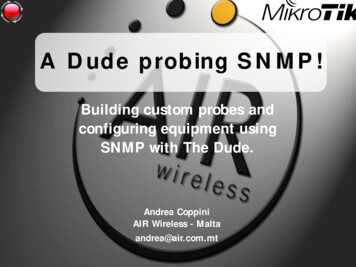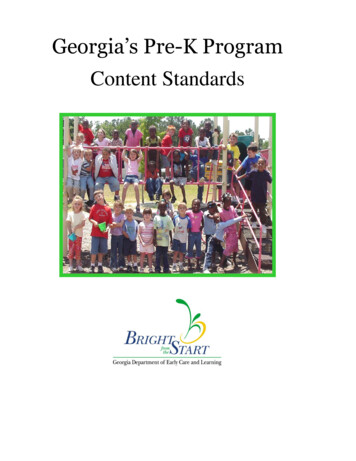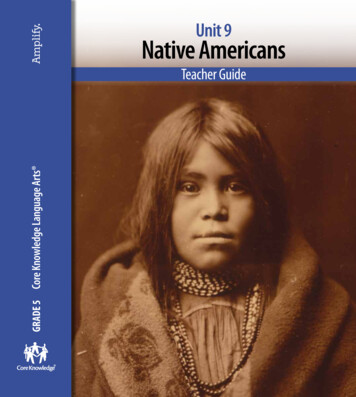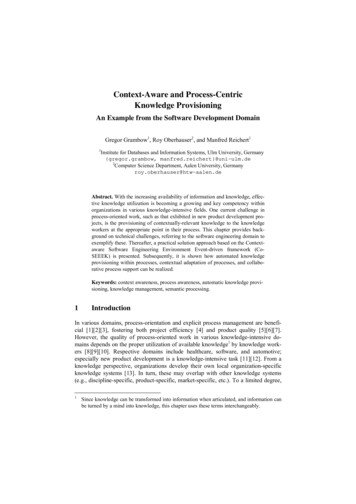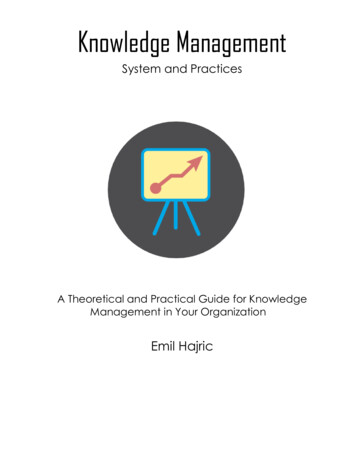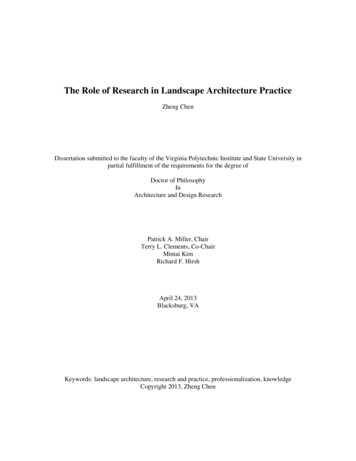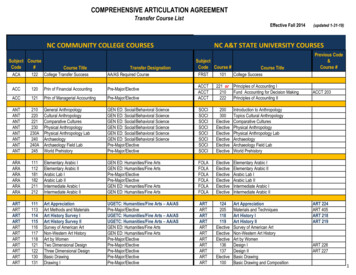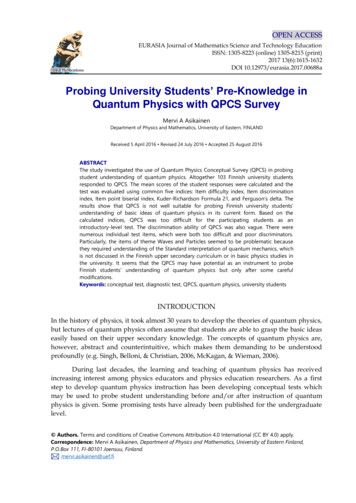
Transcription
OPEN ACCESSEURASIA Journal of Mathematics Science and Technology EducationISSN: 1305-8223 (online) 1305-8215 (print)2017 13(6):1615-1632DOI 10.12973/eurasia.2017.00688aProbing University Students’ Pre-Knowledge inQuantum Physics with QPCS SurveyMervi A AsikainenDepartment of Physics and Mathematics, University of Eastern, FINLANDReceived 5 April 2016 Revised 24 July 2016 Accepted 25 August 2016ABSTRACTThe study investigated the use of Quantum Physics Conceptual Survey (QPCS) in probingstudent understanding of quantum physics. Altogether 103 Finnish university studentsresponded to QPCS. The mean scores of the student responses were calculated and thetest was evaluated using common five indices: Item difficulty index, Item discriminationindex, Item point biserial index, Kuder-Richardson Formula 21, and Ferguson’s delta. Theresults show that QPCS is not well suitable for probing Finnish university students’understanding of basic ideas of quantum physics in its current form. Based on thecalculated indices, QPCS was too difficult for the participating students as anintroductory-level test. The discrimination ability of QPCS was also vague. There werenumerous individual test items, which were both too difficult and poor discriminators.Particularly, the items of theme Waves and Particles seemed to be problematic becausethey required understanding of the Standard interpretation of quantum mechanics, whichis not discussed in the Finnish upper secondary curriculum or in basic physics studies inthe university. It seems that the QPCS may have potential as an instrument to probeFinnish students’ understanding of quantum physics but only after some carefulmodifications.Keywords: conceptual test, diagnostic test, QPCS, quantum physics, university studentsINTRODUCTIONIn the history of physics, it took almost 30 years to develop the theories of quantum physics,but lectures of quantum physics often assume that students are able to grasp the basic ideaseasily based on their upper secondary knowledge. The concepts of quantum physics are,however, abstract and counterintuitive, which makes them demanding to be understoodprofoundly (e.g. Singh, Belloni, & Christian, 2006, McKagan, & Wieman, 2006).During last decades, the learning and teaching of quantum physics has receivedincreasing interest among physics educators and physics education researchers. As a firststep to develop quantum physics instruction has been developing conceptual tests whichmay be used to probe student understanding before and/or after instruction of quantumphysics is given. Some promising tests have already been published for the undergraduatelevel. Authors. Terms and conditions of Creative Commons Attribution 4.0 International (CC BY 4.0) apply.Correspondence: Mervi A Asikainen, Department of Physics and Mathematics, University of Eastern Finland,P.O.Box 111, FI-80101 Joensuu, Finland.mervi.asikainen@uef.fi
M. A. Asikainen / Probing Students’ Pre-Knowledge in Quantum PhysicsState of the literature Diagnostic tests are widely used to probe student understanding in physics. There are validatedtests for domains such as mechanics (FCI), electromagnetism (CSEM), and electricity (CSE) thatcan be used in different educational and cultural contexts.In quantum physics, the development of a suitable, generic diagnostic test is still ongoing.Some tests have been developed for different educational levels and for different purposes butthe tests are mainly validated within the same culture and country.QPCS is a promising survey aimed at introductory level. It has been validated with Australianuniversity students.Contribution of this paper to the literature In this study, QPCS is used and evaluated in Finnish context.The study gives information on the usability of QPCS in other cultural and educational context.QPCS is examined with the same indices than in the original study, therefore, the results help tovalidate the test further.The study also informs about the level of quantum understanding of Finnish universitystudents.Cataloglu and Robinett (2001) introduced a test called Quantum Physics VisualizationInstrument (QPVI) that concentrates on students’ conceptual and visual understanding ofquantum mechanics at intermediate or advanced level. The test covers topics such as theprobabilistic interpretation of the Schrödinger equation, the properties of solutions of theSchrödinger equation, the uncertainty principle, and the Pauli Exclusion Principle. Almost allthe test questions include visualizations. The QPVI consists of 25 questions and a studentselects the correct response of given five choices. In addition, a student is asked to explainhis/her answers with one or two sentences after each question. A student’s confidence abouthis/her answer is probed with a four-scale very certain, somewhat certain, somewhatuncertain, very uncertain. The QVMI has been used to find out the development of quantumunderstanding of senior physics majors only a few studies, such as Belloni and Christian(2003).Another test that is suitable for probing student quantum understanding at universitylevel is Quantum Mechanics Conceptual Survey (QMCS) (McKagan & Wieman, 2006;McKagan, Perkins, & Wieman, 2010). It consists of 12 questions addressing the essentialtopics of quantum mechanics, such as wave function and probability, wave-particle duality,Schrödinger equation, the quantization of states, uncertainty principle, superposition,operators and observables, and tunnelling. The developer’s original idea was to construct atest applicable at all the levels of university education to evaluate different instructionalideas used in the teaching of quantum mechanics. However, they realised that it is notpossible to construct a test suitable for all educational levels because there is no consensusabout the basic concepts of quantum mechanics. QMCS is the most suitable for sophomore-1616
EURASIA J Math Sci and Tech Edlevel as a post-test (McKagan, Perkins, & Wieman, 2010), which makes it usability ratherlimited.Chapman, Hunt and Walet (2013) recently described the development of a QuantumMechanics Diagnostic Questionnaire for investigating third-year students’ quantumunderstanding after their first quantum physics course. The questionnaire included both selfevaluation questions concerning confidence and understanding and questions aboutmathematics, time-dependence, and general topics of quantum physics. Unfortunately, thefinal version of the questionnaire has not been published yet.It seems that there is only one diagnostic test available for the introductory quantumphysics at the moment. Wuttiprom, Sharma and Johnston (2009) designed and validated aconceptual test entitled Quantum Physics Conceptual Survey (QPCS) that concentrates onconceptual understanding of the basic quantum concepts. The test covers five themes:photoelectric effect, waves and particles, de Broglie wavelength, double-slit interference, anduncertainty principle. The authors have used QPCS to discover quantum understanding offirst and second year university students in Australia. Even if the test has not been used inother educational contexts, it seemed to be the most suitable for our teaching and researchpurposes.In this study, the use of QPCS instrument in the Finnish university context wasexamined. The aim was to evaluate the use of QPCS in probing quantum understanding ofFinnish university students in the beginning of an introductory level course on quantumphysics. The following research questions were phrased:1. What is the level of Finnish students’ pre-knowledge in quantum physics in thebeginning of the introductory course on quantum physics measured with QPCS?2. How valid is QPCS in the context of Finnish university physics education?The first research question is answered by examining the mean scores and the themescores of the QPCS of the Finnish sample. The second question related to the validity of theQPCS instrument is responded by calculating five different indices commonly used inevaluating conceptual tests (Ding, Chabay, Sherwood, & Beichner, 2006; Ishimoto, Thornton,& Sokoloff, 2014). Wuttiprom, Sharma and Johnston (2009) have also used these indices intheir study to validate QPCS.By answering these questions, the applicability of QPCS in a new cultural context isevaluated, which has theoretical relevance. The practical relevance of this study is achieved ifthe results favour the use of QPCS as a diagnostic test in the beginning of Finnish quantumphysics courses.METHODThe Quantum Physics Conceptual Survey (QPCS) developed by Wuttiprom, Sharmaand Johnston (2009) consists of 25 multiple-choice items that belong to five themes, see Table1. The developers of the test have chosen these themes because they consider them as the1617
M. A. Asikainen / Probing Students’ Pre-Knowledge in Quantum PhysicsTable 1. Items of QPCS in five themesThemeItems (questions)1Photoelectric effect1-32Waves and particles4-73de Broglie wavelength8-144Double-slit interference15-195Uncertainty principle20-25basic concepts of quantum physics. The author and her colleagues translated the survey intoFinnish for the purposes of this research. They all are experts in the field of physicseducation research and have already translated several conceptual tests into Finnish. Theauthor performed the first translation and some occurring issues were discussed together tofind the best possible way to formulate test items. Furthermore, a third physics educationresearcher evaluated the readability of the test.Participants of the quantum physics course responded to the questionnaire in thebeginning of the course in quantum physics. Table 2 gives basic information about theparticipants. The participants were mostly majors of mathematics, physics, and chemistry. Amajority of the participants were third-year students. All the students had taken the basicphysics courses and traditional intermediate university courses in thermal physics,electromagnetism, and optics. The response time was approximately 30 minutes. The testwas voluntary but all the participants attending the opening lecture of the course respondedthe test. A 5% bonus for the course exam was given to participating students.Because the number of participants in the course varies between 35-45 students, thedata was collected during three years (2012, 2013, and 2014) to get enough data for statisticalanalyses. The number of students who responded to the test was 29 in the first course, 37 inthe second, and 37 in the third course, 103 in total.The questionnaire data was analysed with the key of correct responses that wasreceived from the developers of the test. First, it was ensured that there is no statisticaldifference between the mean scores of the three different course samples so treating themTable 2. Basic information about the participants (N 103) of the quantum physics courseMajor subjectTeacher educationSubject hemistry48Other4*Students qualify as a mathematician, physicist, or chemist**Some students studied in open university or in-service training1618Other**8
EURASIA J Math Sci and Tech Edtogether is valid (df 2, F 0.140, p .334). This also showed that cohorts are similar in respectof their pre-knowledge, and therefore, the test really measures student understanding ofquantum physics. Then, the mean scores of correct responses in each item and in five themeswere calculated.Furthermore, five indices were calculated to evaluate the difficulty and thediscrimination of the test following Classical test theory (e.g. Engelhardt, 2009) commonlyused in studies of this kind that aim to evaluate the reliability, validity, and discrimination aconceptual test (Ding, Chabay, Sherwood, & Beichner, 2006; Wuttiprom, Sharma, &Johnston, 2009; Ishimoto, Thornton, & Sokoloff, 2014). These indices were Item difficultyindex (DiffI), Item discrimination index (DiscI), Item point biserial index (BisI), Ferguson’sdelta, and Kuder-Richardson Formula 21. With the help of an item analysis, it can beexamined do the items function well or do they need to be reworked or edited (Engelhardt,2009). These indices are introduced in detail in results section.RESULTSQPCS mean scoresThe analysis of the data revealed that the mean score of the Finnish sample is 45.9 13.6%. It is almost identical with the mean score reported by the developers of the test.Wuttiprom, Sharma and Johnston (2009) studied first-year Australian physics students(N 95) in the beginning of a technology-oriented introductory physics course in the studyand received means score 45.9 12.8%. However, a theme-based examination revealed somesimilarities and differences between the Finnish and the original student samples, as can beseen from Table 3.Table 3. The mean scores and standard deviations by themes of the Finnish sample compared withthe results of the original sample, derived from Wuttiprom, Sharma and Johnston (2009)Mean score and standard deviationThemeFinnish sampleOriginal sampleOverall45.9 13.645.9 12.81Photoelectric effect40502Waves and particles20233de Broglie wavelength43544Double-slit interference63565Uncertainty principle4238The mean scores were low in both the student groups but the comparison of meanscores shows that our results are well in line with the results by Wuttiprom, Sharma andJohnston (2009). The trend is similar in both student groups: same themes were easy ordifficult for students. The students were the most familiar with the theme Double-slitinterference and theme Waves and particles was the most difficult one for them.1619
M. A. Asikainen / Probing Students’ Pre-Knowledge in Quantum PhysicsItem DifficultyItem difficulty was evaluated by using Item difficulty index, which measures theproportion of students’ correct responses item by item (Wuttiprom, Sharma, & Johnston,2009; Ding, Chabay, Sherwood, & Beichner, 2006). The values are between 0 and 1. Valuesclose to 1 mean that most of the respondents answered the item correctly and 0 that mostrespondents did not answer correctly (Engelhardt, 2009). Value 0.3 is considered to meanthat the item is too difficult whilst value 0.9 indicates that the item is too easy. Theoptimum value of the mean of the indices is 0.5. The mean of the Item difficulty indices ofthe sample is near the optimum value, IDiff 0.46 0.5.Difficulty indexAs can be seen from Figure 1, there are six too difficult items for the Finnish students.The most worrying observation is that three of these items (4, 5, and 7, see Appendix) belongto the theme Waves and particles, which makes the validity of the whole theme questionable.Based on the Item difficulty index, there is only one item of this theme (item 6) is suitable forprobing the level of student pre-knowledge. The effect of items 9, 10, and 11 is not sosignificant because that particular theme, de Broglie wavelength, also includes four otheritems that were acceptable based on the item difficulty 123456789 10 11 12 13 14 15 16 17 18 19 20 21 22 23 24 25Item (question)Figure 1. QPCS item difficulty indices based on a sample of 103 Finnish students’ pre-test results.Optimum values lie between 0.3 and 0.9 (marked with red lines)DiscriminationDiscrimination was evaluated with three different measures: Item discriminationindex, Item point biserial coefficient, and Ferguson’s delta. Items that discriminate wellincrease the variance and make the test more reliable (Engelhardt, 2009).Item discrimination index measures the ability of a test to discriminate low-scoringand top-scoring students. It can be calculated as a difference of top 25% scorers and bottom25% scorers who responded correctly (Wuttiprom, Sharma, & Johnston, 2009; Ding, Chabay,Sherwood, & Beichner, 2006). The range of possible values is between -1 and 1, and a value 1620
EURASIA J Math Sci and Tech Ed0.3 indicates that the item discriminates well. The overall mean score of the Itemdiscrimination index was 0.34, which is a little bit above the desirable value of 0.3.Item discrimination indexAs Figure 2 shows, ten items are poor discriminators. Again, items 4 and 5 belongingto the theme Waves and particles are of concern. In addition, items 9 and 10 related to deBroglie wavelength fail according to the item discrimination index. The most worrying itemsbelong to the theme Double-slit experiment. Of the five items of the theme, only one item(19) discriminates students 0,10-0,20123456789 10 11 12 13 14 15 16 17 18 19 20 21 22 23 24 25Item (question)Figure 2. QPCS item discrimination indices based on a sample of 103 Finnish students’ pre-testresults. Optimum values lie above 0.3 (marked with a red line)Another calculated index was Item point biserial coefficient that measures therelationship between a student’s correctness on the given item and his/her score on theoverall test (Wuttiprom, Sharma, & Johnston, 2009). It is computed as a correlation coefficientbetween the item scores and the total scores (Ding, Chabay, Sherwood, & Beichner, 2006).The values lie between -1 and 1, and value 0.2 is considered acceptable.The results in Figure 3 show that 13 items are poor discriminators in our sample.These items do not differentiate students appropriately. Several themes, such asPhotoelectric effect, Waves and particles, and Double-slit experiment are problematicbecause most of their items are not good discriminators.1621
M. A. Asikainen / Probing Students’ Pre-Knowledge in Quantum PhysicsItem point biserial coefficient0,60,50,40,30,20,10-0,1-0,2123456789 10 11 12 13 14 15 16 17 18 19 20 21 22 23 24 25Item (question)Figure 3. QPCS Item point biserial coefficients based on a sample of 103 Finnish students’ pre-testresultsSelf-consistencySelf-consistency of the test was evaluated using Kuder Richardson Formula 21 (KR21). KR21 measures the self-consistence of the whole test and it is based on the covariances ofdichotomously scored items (Engelhardt, 2009). The values lie between 0 and 1 (Ding,Chabay, Sherwood, & Beichner, 2006). The calculation gave 0.49, which is below therecommended value of 0.7.Comparison of problematic itemsFor a more detailed analysis of the problematic items, problematic items based onthree indices, Item difficulty index, Item discrimination index, and Item biserial coefficientindex, were cross-tabulated and compared with the results by Wuttiprom, Sharma andJohnston (2009), see Table 4.As can be seen from Table 4, there are five items that fail in all the three indices, items3, 4, 5, 9, and 10 (see Appendix). These items should definitely be re-considered to enhancethe validity of the Finnish version of the QPCS. Four items that were unsuccessful in twoindices (16, 17, 18, and 20) are also worrying and should be examined in more detailed. Itemsthat fail in one index (3, 4, 5, 7, 9, 10, and 11) may have minor issues that cause their failure inthe test.Furthermore, there are eight items (3, 4, 5, 6, 7, 10, 11, and 20) that are problematicaccording to the results of this study and the results reported by Wuttiprom, Sharma andJohnston (2009). This observation may indicate that the validity of the original QPCS mightbe further improved by paying attention to these items.1622
EURASIA J Math Sci and Tech EdTable 4. Cross-tabulation of problematic items by three indices in QPCS test in the Finnish and originalsamples. IDiffI Item difficulty index, IDiscI Item discrimination index, and IPBI Item biserialcoefficient N AND CONCLUSIONSThe study examined the use of Quantum Physics Conceptual Survey (QPCS) inevaluating Finnish university students’ pre-knowledge in introductory quantum physics.Based on the calculated indices, there are some concerns on the Finnish version of QPCS thatshould be taken into account before a wider use of the test as a pre-test in quantum physics.The results showed that the Finnish students’ mean score in QPCS was 45.9% that isexactly the same than the mean score by Australian first-year physics students in a study byWuttiprom, Sharma and Johnston (2009).1623
M. A. Asikainen / Probing Students’ Pre-Knowledge in Quantum PhysicsThe results also showed that QPCS was somewhat difficult for the Finnish studentsparticipating in the test. Especially the themes Waves and particles and de Brogliewavelength caused problems for the participants. The discrimination ability of the wholetest, Ferguson’s delta, was above the recommended value but the discriminatory power of itsindividual items was not very good. These contrasting results should be taken with cautionbecause it has recently been claimed that Ferguson’s delta is not a good measure ofdiscrimination (Terluin, Knol, Terwee, & de Wet, 2009). Altogether six items out of 25 wereproblematic in three indices. In total, eight items have also been reported being problematicby Wuttiprom, Sharma and Johnston (2009). The measure of self-consistency, KR-21 index,was not satisfactory.The moderate level of student understanding of quantum physics is not surprising,because the quantum pre-knowledge of the Finnish students participating QPCS is mainlybased on their upper secondary school studies and basic physics courses at the universitylevel. Our students are majors of mathematics, physics, or chemistry, and it is possible thattheir secondary studies do not include anything about quantum physics, because the coursecalled Modern physics is a voluntary course for students and only a minority of uppersecondary students finish it. It can be estimated that about a half of the students participatedin this study have taken the course in the upper secondary school. The contents of the courseare various because it covers the main ideas of modern physics from quantum physics,relativity, and particle physics. The themes photoelectric effect and waves and particles areexplicitly mentioned in the national core curriculum (Finnish National Board of Education,2004) but also de Broglie wavelength, double-slit interference, and uncertainty principle arediscussed in upper secondary textbooks. It is probable that high school teaching does notoften lead to profound understanding of these counterintuitive topics.The basic university physics courses at our university discuss the topics of quantumphysics during a tight timeframe and with rather lightweight style based on the book byRandall Knight (Knight, 2013). The double-slit experiment, de Broglie wavelength, wavesand particles are briefly introduced, but the photoelectric effect has more weight in teaching.The photoelectric effect is also one topic of our students’ intermediate laboratory work,which is recommended to be taken before the intermediate course on quantum physics.According to our knowledge, only a few students do obey the recommended structure ofstudies.These factors may partly explain somewhat modest level of student quantumunderstanding. As Wuttiprom, Sharma and Johnston (2009) have stated, “it seems thatlearning quantum physics at a higher level with standard instruction does not necessarily cementunderstanding of the introductory concepts.”Some students also commented that they are not familiar with the Standard(Copenhagen) interpretation of quantum mechanics, which exist in six items of threedifferent themes. Four of these items constitute the theme Waves and particles, which was1624
EURASIA J Math Sci and Tech Edthe most difficult theme for the students and which was shown to be a poor discriminator aswell. The Standard interpretation of quantum mechanics is not discussed in the Finnishupper secondary textbooks and it does not include in the basic physics curriculum in ouruniversity. In the Finnish version of QPCS, this theme could be modified, ignored orreplaced with another theme based on upper secondary quantum physics.We also think that there is some contentual overlap between the themes Waves andparticles (wave-particle dualism) and de Broglie wavelength, which makes these themesinterrelated. Wave-particle dualism cannot be understood without understanding theconcept of de Broglie wavelength and vice versa. This supports also the need for reformulating QPCS for our purposes.These results suggest that QPCS has potential and it could be a valid instrument tomonitor student understanding of quantum physics after some careful modifications thattake the main domains of the Finnish upper secondary school syllabus into account. Ourresults suggest that in the current state, QPCS may not work well as a pre-test if students’pre-knowledge is vague or they have not been studied the themes of QPCS. Our study alsoverified some problematic items already noted by the developers of the test. The validity ofthe original QPCS can be further improved by paying attention to these items.We encourage other users of QPCS to evaluate the test with their own samples beforean implementation of the test. It is possible that there are differences in the amount andextent of quantum physics in the national syllabuses that may have an effect on the level ofuniversity students’ pre-knowledge. This means that same test does not necessarily work asit is supposed to do in different cultural environments.Next in this research project, a modified QPCS will be developed and tested. We hopethat the novel version can be used as a more valid tool in probing student understanding ofquantum physics both in the beginning and in the end of the course quantum physics in theFinnish universities.REFERENCESBelloni, M., & Christian, W. (2003). Physlets for quantum mechanics. Computing in Science &Engineering, 5(1), 90–97.Cataloglu, E. & Robinett, R. W. (2002). Testing the development of student conceptual andvisualization understanding in quantum mechanics through the undergraduate career.American Journal of Physics, 70(3), 238–251, DOI: 10.1119/1.1405509Chapman, J. R., Hunt, S. O., & Walet, N. R. (2013). A measurement of quantum fears. New Directions,9(1), 66–76, DOI:10.11120/ndir.2013.00008Ding, L., Chabay, R., Sherwood, B., & Beichner, R. (2006). Evaluating an electricity and magnetismassessment tool: Brief electricity and magnetism assessment. Physical Review Special Topics–Physics Education Research, 2(1), 010105, DOI: 10.1103/PhysRevSTPER.2.0101051625
M. A. Asikainen / Probing Students’ Pre-Knowledge in Quantum PhysicsEngelhardt, P. (2009). An introduction to classical test theory as applied to conceptual multiple-choicetests.InGettingStartedinPER .org/Repository/document/ServeFile.cfm?ID 8807&DocID 1148Finnish National Board of Education. (2004). National core curriculum for general upper r9,2015,fromhttp://www.oph.fi/english/curricula and qualifications/general upper secondary educationHankins, M. (2008). How discriminating are discriminative instruments? Health and Quality of LifeOutcomes, 6(36). Retrieved December 1, 2015, from shimoto, M., Thornton, R. K., & Sokoloff, D. R. (2014). Validating the Japanese translation of the Forceand Motion Conceptual Evaluation and comparing performance levels of American andJapanese students. Physical Review Special Topics–Physics Education Research, 10. 020114, DOI:10.1103/PhysRevSTPER.10.020114Knight, R. (2013). Physics for scientist and engineers. A Strategic Approach. San Francisco: PearsonAddison-Wesley.McKagan, S. B., & Wieman, C. E. (2006). Exploring Student Understanding of Energy through theQuantum Mechanics Conceptual Survey. AIP Conference Proceedings, 818, 65–68.McKagan, S. B., Perkins, K. K., & Wieman, C. E. (2010). Design and validation of the QuantumMechanics Conceptual Survey. Physical Review Special Topics–Physics Education Research, 6(2),020121, DOI: 10.1103/PhysRevSTPER.6.020121Singh, C., Belloni, M., & Christian, W. (2006). Improving students' understanding of quantummechanics. Physics Today, 59(8), 43–49, DOI: 10.1063/1.2349732Terluin, B., Knol, D. L., Terwee, C. B., & de Wet, H. C. W. (2009). Understanding Ferguson's δ: time tosay good-bye? Health and Quality of Life Outcomes, 6(38), DOI: 10.1186/1477-7525-7-38Wuttiprom, S., Sharma, M. D., & Johnston, I. D. (2009). Development and use of a conceptual surveyin introductory quantum physics. International Journal of Science Education, 31(5), 631–654, DOI:10.1080/09500690701747226.APPENDIXQuantum Physics Conceptual Survey (QPCS)(Republished with a permission by the authors)Questions 1 through 3 refer to the following.In a hypothetical experiment to demonstrate the photoelectric effect, a light source ofvariable frequency is shone on a photo-sensitive surface. Ejected photoelectrons are collectedby an anode. A graph of the resulting photocurrentas a function of frequencylookslike this.If1626
EURASIA J Math Sci and Tech EdSelect your answers to the questions below from these graphs.A.B.IC.IfD.IfIffWhich graph would be most appropriate when,1. the intensity of the light is increased?2. the work function of the surface is increased?3. In an experiment to demonstrate the photoelectric effect the following observations aremade: light of high frequency shone onto some materials causes electrons to be ejected; and if the frequency of light is decreased (with any amplitude) there is a cut-off frequencybelow which electrons are no longer ejected.These observations are believed to support a particle theory of light, rather than a wavetheory. Which one of the statements is inconsistent with the observations?A. In a particle theory, ejection of electrons is explained by collisions with photons. Eachcollision can give a single electron enough energy to escape.B. In a wave theory, ejection of electrons
Keywords: conceptual test, diagnostic test, QPCS, quantum physics, university students INTRODUCTION In the history of physics, it took almost 30 years to develop the theories of quantum physics, but lectures of quantum physics often assume that students are able to grasp the basic ideas easily based on their upper secondary knowledge.
